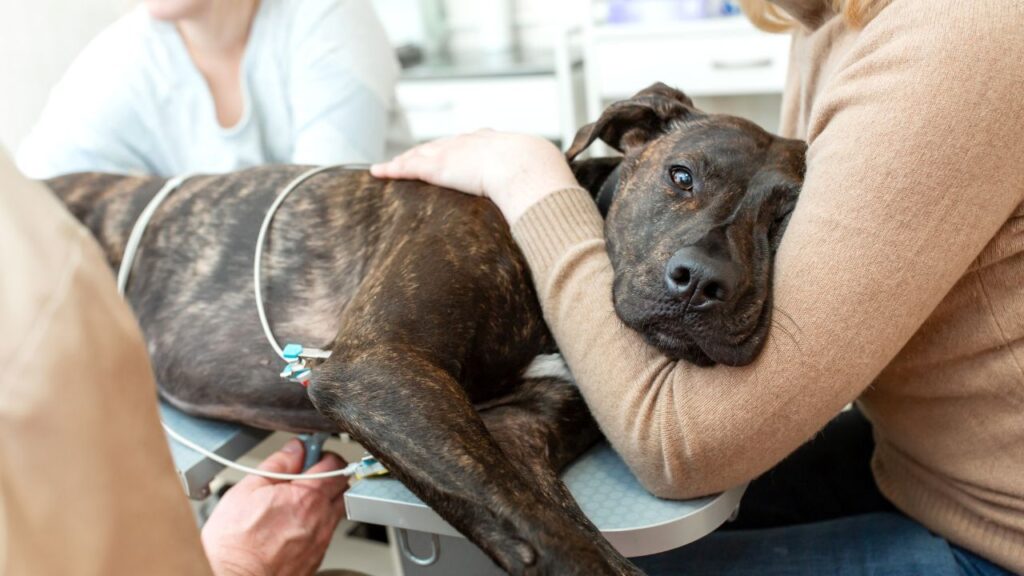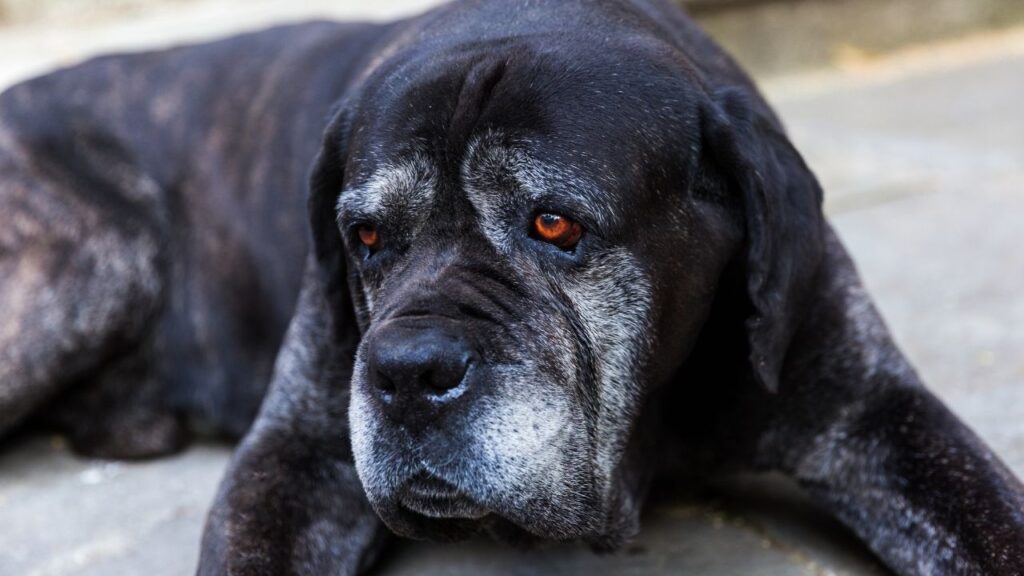Liver cancer may sound like a terrifying diagnosis, but the liver has great regeneration capacity. Even if a large portion of the liver is damaged, injured, or surgically removed, the remaining healthy liver can rebuild itself. Promptly treating many forms of liver cancer in dogs can lead to normal life quality and longevity.
Key Takeaways
- How long dogs can live with liver cancer depends upon the tumor type and treatments.
- Even some malignant tumors, if treated, can result in survival times of several years. Without removal, the prognosis is poorer, less than half a year.
- Dogs with liver cancer are not necessarily in pain, however, they may know something doesn’t feel right.
- Early signs of liver cancer in dogs may be nothing or general non-specific symptoms like not wanting to eat, diarrhea, abdominal pain, increased urination, and lethargy.
- Because these symptoms could be caused by many illnesses, and liver cancer is relatively rare, it sometimes takes a while to diagnose.
- The final stages of liver cancer in dogs are usually related to a liver tumor rupturing or liver failure.
- Many liver cancer tumor types in dogs are slow-growing, however, other tumor types can grow fast and metastasize. Because so many different types of cancers can occur in the liver, it’s hard to make a general statement about how “slow or fast” it is.
- Surgery isn’t always possible for liver cancers so chemotherapy may be recommended for your dog. This sometimes delays the progression of liver cancer in some types but is unlikely to cure it completely.
- Genetics may play a role in liver cancer in dogs, but a definitive cause has not been established.
Liver Cancer in Dogs: Benign or Malignant? Primary, or Secondary?
There are many types of liver cancer in dogs. A few are benign, and others are malignant. We’ll be covering both in this article.
Liver cancer in dogs might be a primary tumor, which starts in the liver, or a secondary tumor, which starts somewhere else and metastasizes to the liver.
Finding out what type of tumor your dog has is an important part of helping your dog with liver cancer.
We will discuss the different types of tumors below, but first, let’s look at the liver’s location and function in your dog’s body.
Where the Liver Is and What It Does for Your Dog
The liver and its partner organ, the gallbladder, sit in the abdominal cavity just behind the diaphragm, a large breathing muscle.
The liver has six lobes or sections. Cancer can develop in one or more of these lobes.
This important organ plays several critical roles in keeping a dog’s body functioning normally.
- helps maintain a healthy metabolism
- filters the blood of toxins
- produces waste products for elimination through feces and urine
- produces and stores important substances the body needs for energy, digestion, and blood clotting
The liver is a hard-working organ that is essential for quality of life. When it becomes impaired, all the functions above may suffer.
Gallbladder, Liver’s Partner
The gallbladder can also be affected by liver cancer in dogs. Like in humans, the gallbladder is a small, balloon-like structure that stores bile, an important part of digestion.
The dog’s gallbladder is sandwiched in between the lobes of the liver. Cancer can develop in the liver and invade the gallbladder, develop in both organs, or the gallbladder alone can have cancer.
Either way, both organs are intricately involved with each other.
How Veterinarians Describe Liver Cancer, and Why It Matters
When liver and/or gallbladder cancer develops, it can occur in one or multiple places in these organs. There are many types of cells found in these organs, and so there are several cancer types that can arise.
To help with treatment decisions, veterinarians like to describe a tumor type precisely. When it comes to liver cancer, typically, veterinarians will describe the following characteristics:
- Type of tumor and whether it is benign (non-cancerous) or malignant (cancerous).
- Location of the tumor and whether it began as a primary tumor in the liver or metastasized (spread) from somewhere else.
- Distribution of the tumor. Is it focal (just in one area of the liver) or diffuse (throughout the entire organ)?
- Whether the tumor has spread to nearby (or distant) lymph nodes and/or other body organs.
These factors will govern what treatments may or may not be offered and affect the likely outcome, or prognosis.

Poodles are predisposed to hemangiosarcoma, which can occur in the liver.
General Statistics and Facts About Liver Cancer in Dogs
- Liver cancer in dogs is very rare, with only about 1% of dogs being affected by this type of cancer.4,6
- Age appears to influence the chances of developing liver cancer, as most dogs are ten or older at diagnosis.6
- Statistics do not support a strong relationship between liver cancer and specific breeds of dogs.
- Gender has not been shown to be a significant factor in developing liver cancer but may have an influence on the type of liver cancer a dog develops. Female dogs are more prone to bile duct carcinomas, and male dogs are more prone to hepatocellular carcinoma.4,7
- Existing liver disease may be influential in predisposing older dogs to developing liver cancer.
- One study found that dogs undergoing surgical treatment who were lethargic at the time of diagnosis have a ten times higher mortality risk than dogs without lethargy.8
Benign Liver Tumors
Some liver cancers are benign, meaning not cancerous.
While technically not cancerous, they can be initially mistaken for malignant tumors, because you can’t tell whether a tumor is malignant or benign just by looking at it or seeing an image.
That’s why when veterinarians discover a mass (tumor) in the liver, additional tests will be conducted to distinguish whether it is benign or malignant (see below).
Benign tumors are not a risk for metastasis (spread). However, they can affect liver function in general, and as noted above, that can compromise health.
Benign liver tumors don’t pose a risk for metastasis, but can compromise liver function, which is why veterinarians like to remove them if possible.
For this reason, removing them, if possible, is a good idea. If a benign tumor is caught early and surgically removed, your dog can have a good prognosis for a normal life quality and life span.
There are three main types of benign liver tumors.
Hepatocellular Adenoma (HCA)
Also referred to as hepatoma, hepatocellular adenoma are benign tumors that arise from epithelial cells of the liver (the cells that line the liver). It usually appears as a large tumor in one liver lobe, but can also be found in multiple sites.1
To ensure that the tumor is hepatocellular adenoma and not its malignant counterpart, hepatocellular adenocarcinoma (HCC), veterinarians diagnose it using ultrasound, fine needle aspirate (FNA), or biopsy.
HCA is a rare and benign tumor that does not spread and has a good prognosis with early detection and surgical removal.
Removing it may be important because it has the potential to rupture and cause abdominal bleeding.2
Nodular Hyperplasia
Nodular hyperplasia is an overgrowth of cells near a blood vessel in the liver. The exact cause of these tumors is unknown, but it may be a response to inflammation.
Dogs with these masses usually don’t have abnormal symptoms, and nodular hyperplasia does not affect liver function.3
Bile Duct Adenoma
Bile duct adenoma is uncommon in dogs. It is a tumor in the bile duct, the tube leading from the gall bladder to the intestine. These benign tumors can block bile flow if they become large, interfering with proper liver and gallbladder function.4
Bile duct adenomas are also called biliary cystadenomas because they are often filled with fluid.
Malignant Liver Tumors
Unsurprisingly, malignant tumors generally have a poorer prognosis than benign tumors. The prognosis will vary depending on the severity of the cancer (see the staging and grading section below).
Several types of malignant tumors or masses occur in the liver in dogs.
Secondary Liver Cancer
Liver cancer is commonly a secondary tumor spread from cancers in other body parts. Some cancers that commonly metastasize to the liver include:
- Exocrine pancreas carcinoma
- Hemangiosarcoma
- Intestinal carcinoma
- Islet cell carcinoma
- Lymphoma
- Mast cell tumors
- Renal (kidney) carcinoma
Depending upon the case, you may not be offered treatment for cancers that have spread to the liver from elsewhere in the body. When metastasis to the liver has occurred, liver cancer treatment may be ineffective or counterproductive.
More information about this is in the prognosis and treatment section below.
Primary Liver Cancer
Several tumor types can start in the liver, so let’s look at the most common primary liver cancer tumor types.
Hepatocellular Carcinoma (HCC)
Hepatocellular carcinoma is the most common type of liver cancer in dogs, accounting for about 50% of malignant canine liver tumors.4
Here’s what you need to know about hepatocellular carcinoma:
- The tumor is slow-growing but can become quite large.
- Eventually, the tumor may cause the liver to bleed within the abdomen.
- If left untreated, the tumor may rupture or cause progressive organ function loss.
- It can compress the liver, leading to end-stage liver disease.
- It may also spread to other body areas, such as the local lymph nodes, heart, lungs, or other organs in the abdomen.
- Surgery is possible with many hepatocellular carcinoma tumors, and dogs can recover if the entire mass can be removed.
- Cancers on the left lobe usually have a better chance of successful removal.4
There are three primary types of canine hepatocellular carcinoma:
- Large, single masses that happen only in one liver lobe are called “massive tumors.” The massive tumor is the most common form of hepatocellular carcinoma in dogs and has a lower rate of metastasis than diffuse or nodular tumors.
- “Nodular tumors” are multiple masses in more than one liver lobe.
- “Diffuse tumors” are not singular lumps or masses but spread throughout the liver lobes. Diffuse tumors that affect several lobes or the entire liver are much harder to treat.4
Bile Duct Carcinoma
Bile duct carcinoma is dogs’ second most common type of liver cancer.4 Here’s what you need to understand about this type of dog liver cancer.
- Bile duct carcinoma begins in the bile ducts, which carry bile from the gallbladder to the intestine.
- Bile duct carcinoma is more likely to be found in the left lobe of the liver.
- Bile duct carcinoma can be aggressive and spread to other organs, including the lungs, lymph nodes, kidneys, pancreas, bladder, spleen, and bone.
- Not only is this a malignant tumor that can spread, but it can also block the bile duct, which could disrupt bile flow.
Bile duct carcinoma can be further classified in a couple of ways:
- Like hepatocellular carcinoma, there are three types of bile duct carcinomas:
- Massive tumors are single, large tumors.
- Nodular tumors are multiple masses.
- Diffuse tumors are not singular masses but are spread out.
- Whether massive, nodular, or diffuse, these tumors can be intrahepatic (within the liver), extrahepatic (situated or originating outside the liver), or within the gallbladder. Intrahepatic tumors are more common in dogs.4
Hemangiosarcoma (HSA)
Hemangiosarcoma is malignant cancer that forms in the cells of the inner lining of blood vessels. It can occur anywhere there are blood vessels, including the liver.
The liver is not a typical place for hemangiosarcoma to start: primary hemangiosarcoma tumors account for approximately 5% of all hemangiosarcoma cases.4,5 However, hemangiosarcoma commonly metastasizes to the liver from other primary locations.
Hemangiosarcoma of the liver in dogs spreads quickly to other organs like the brain and heart, and survival time is limited unless detected early and treated aggressively.
Histiocytic Sarcoma
Histiocytic sarcomas are cancerous soft tissue sarcomas that begin from proliferating (rapidly replicating) abnormal immune cells. These aggressive tumors spread quickly to the lymph nodes, bone marrow, lungs, and spleen.
Neuroendocrine Tumors
Also known as carcinoids, these are a group of tumors that develop from the abnormal growth of neuroendocrine system cells. This body system performs nerve and hormone-like functions. These tumors are very rare in dogs.4
Surgery may be possible and may be followed by chemotherapy. The prognosis is poor due to a high rate of metastasis.
Canine Liver Cancer Causes
A definitive cause for most types of liver cancer has not been established. Genetics may play a role, but like all cancers, liver cancer is a multifactorial disease, meaning multiple things must go wrong for it to take hold.
Risk Factors for Liver Cancer in Dogs
Age appears to influence the chances of developing liver cancer because most dogs are ten or older at diagnosis.
While liver cancer is more common in older dogs, it can also occur at any age.
Diseases that affect the liver, including inflammation, liver damage, and hyperadrenocorticism (Cushing’s disease), may be potential risk factors for developing hepatocellular carcinoma.9
No breed risks have been identified for primary liver cancer. However, several cancers that like to spread to the liver have known breed predispositions. For example, breeds prone to hemangiosarcoma (which may spread to the liver) include Poodles, German Shepherds, Rottweilers, and Golden Retrievers.
Dr. Nicole Sheehan explains why so many dogs need a liver detox long before they show elevated bloodwork on DOG CANCER ANSWERS.
Symptoms of Liver Cancer in Dogs
Liver cancer may be difficult to diagnose because many dogs are not symptomatic or have non-specific symptoms that many illnesses or health problems could cause.
It is common for dogs to have no symptoms at all. One in four dogs with liver or bile duct tumors may have no symptoms. Dogs with cancerous (malignant) tumors have symptoms more often. 4
Liver cancer may advance significantly before signs appear because signs of a problem are often non-specific, meaning they could happen in many other, more common diseases.4
Common symptoms of liver cancer include:4
- Abdominal pain
- Collapse and acute shock due to tumor rupture
- Decreased appetite
- Diarrhea
- Enlarged or distended abdomen due to fluid accumulation in the abdomen (hemoabdomen)
- Excessive thirst
- Increased urination
- Jaundice or icterus (yellowing of the skin, eyes, and gums)
- Lethargy
- Vomiting
- Weakness, poor coordination, or dullness
- Weight loss
Diagnosing Liver Cancer in Dogs
Veterinarians need to perform several tests to diagnose liver cancer fully and accurately. Even if they suspect liver cancer after physically examining your dog, they cannot tell whether it is present from a physical exam alone.
Because other more common conditions might be causing liver problems, you might look at many tests to rule out other conditions before finally getting a liver cancer diagnosis.
As you’ll see from the list below, many of these tests will help paint a picture of your dog’s liver’s health, but not necessarily be definitive for liver cancer itself. Imaging may be required to get a full picture using techniques like X-ray, ultrasound, magnetic resonance imaging (MRI), and computerized tomography (CT).
Ultimately, fine needle aspiration or biopsy of the liver may also be necessary to determine if cancerous cells are present.
Physical Exam
During an exam, your veterinarian might feel liver enlargement, fluid accumulation, and abdominal pain. There may also be a yellow appearance to the ears and gums, indicating jaundice. Even if these signs are present, however, your veterinarian will need to run other tests to be sure the cause of these signs and symptoms is liver cancer.
Urinalysis
Urinalysis is often ordered when a veterinarian tries to determine why a dog is unwell. Urine analysis in dogs with liver cancer may show changes in urine concentration and pH.
Blood Chemistry and Complete Blood Count (CBC)
These are common blood tests to help a veterinarian understand your dog’s health in general.
If liver cancer is present, blood cell counts may show a decrease in red blood cell numbers and platelet abnormalities.
Blood chemistry will often reveal changes that are a consequence of damage to the liver and gallbladder.
However, the severity of changes in bloodwork does not always correspond to the severity of liver disease in dogs; dogs with liver tumors may have normal blood work or only mild elevations.4
Bile Acid Testing
This test assesses liver function in general, so your veterinarian might use it to help them understand what is happening. The bile acid level in your dog’s blood is measured before and after eating a fatty meal to see if the liver and gallbladder are doing their jobs normally. However, if the test is abnormal, that doesn’t mean that cancer is causing the problem because other liver diseases can also cause abnormal results.
Coagulation Profiles
The liver helps produce many components needed for normal blood clotting, so altered liver function may result in abnormal blood clotting; your veterinarian might want to check the coagulation profiles.
In some cases of liver cancer, the coagulation profile may be normal. However, increased prothrombin time (PT), partial thromboplastin time (PTT), and fibrinogen increases are commonly seen.
The liver is very vascular, so coagulation profiles should be checked before fine needle aspiration, biopsy, or surgery to prevent abnormal bleeding during those procedures.4
Alpha-Fetoprotein (AFP)
Alpha-fetoprotein is a protein that is produced in the liver. Changes in AFP suggest severe liver disease, but it is not diagnostic for liver cancer specifically.4
X-rays
X-rays can reveal obvious enlargement or masses in the liver, abdominal fluid, and other abnormalities.4 An X-ray of the chest will also reveal if there is metastasis in the lungs.
Ultrasound
Ultrasound provides detailed imaging of the inside of the liver and other internal organs, so it is a good way to get a “look” at what is happening in your dog. It’s painless and non-invasive, but it does require a specialist with ultrasound training, who will look throughout the abdomen for evidence of tumor activity, like masses and fluid building up where it shouldn’t.
Ultrasound is also frequently used to help veterinarians see what they are doing while they perform biopsies of liver tumors.
Ultrasound may also be used to help with surgical planning.
While helpful as an imaging technique, different liver diseases other than liver cancer may have a similar appearance on ultrasound, so the diagnosis of tumor type and whether it is benign or malignant cannot be made with ultrasound alone.4
Advanced Imaging
MRI and CT scans provide information on the size, location, characteristic features, and extent of tumor spread within the abdomen.1,4
These techniques are also helpful in preparing for surgery by allowing the doctor to see the tumor and any involvement of nearby and distant lymph nodes.
As with ultrasound, liver diseases other than cancer may have a similar appearance on advanced imaging, so the diagnosis of tumor type and whether it is benign or malignant cannot be made with imaging alone.10
FNA and biopsy are still required to characterize the tumor cells and tissues.
Fine Needle Aspirate (FNA) and Cytology
Your veterinarian can collect a small number of cells from the liver mass (using ultrasound to guide their needle) to be examined under a microscope. A correct diagnosis is made 60% of the time with liver aspirates.4
Biopsy
Ultrasound-guided biopsies can also be performed. A biopsy is a more sensitive test than FNA and diagnoses liver cancer 90% of the time.4
Knowing the exact diagnosis helps determine the stage of liver cancer, the treatment plan, and the prognosis.
Surgery
Veterinarians can sometimes perform surgery to take a biopsy or completely remove liver tumors. However, in this delicate organ, most surgeons want to see at least blood work, X-rays, and an ultrasound before surgery.10
Dr. Brooke Britton, veterinary oncologist, guides us through the complex world of cancer diagnosis and staging.
How Long Can a Dog Live with Liver Cancer: Prognosis and Staging
Anyone whose dog has cancer wants to know the disease’s prognosis or likely outcome. To get that information, veterinarians need to assess, or stage, liver cancer.
During staging, they look for the extent of lymph node involvement and if there is metastasis to other organs in the body.
Staging can be expensive and often involves multiple tests.
The benefit of staging is that owners and veterinarians will fully understand the dog’s cancer status. This information can give you an accurate idea of how your dog might respond to treatment options.
That said, staging does not always give information that will change the outcome for a pet. If financial resources are limited, allocating money for supportive care may be the better choice.
Some of the tests used to stage liver cancer in dogs may have already been performed (as above) to rule out other problems in the liver.
- X-rays will show other areas where tumor masses may be present, like the chest (mediastinal mass, pulmonary nodules, consolidation, pleural effusion) or abdomen (enlarged spleen, liver).
- Ultrasonography (ultrasound) is useful in detecting masses in the liver and associated lymph nodes and organs near the primary tumor. Ultrasound is also frequently used to guide the veterinarian using a needle to collect cells for analysis.
- When masses are detected, small amounts of tissues are collected by fine needle aspirate, which can accurately diagnose liver cancer, as noted above.
- Biopsy and histochemistry can assess suspicious masses. These tests allow for more cells to be evaluated using a microscope, and special stains (histology) aid in diagnosing cancer. It also helps determine the patient’s prognosis and can help distinguish between benign and malignant tumors.
- Immunohistochemistry evaluates the cell types based on antibodies binding to the outside of cancer cells.
All of this information helps veterinarians formulate their prognosis.
The Prognosis for Dogs with Liver Cancer
The liver or gallbladder cancer prognosis varies widely and depends on tumor type.
Several tumor types are benign and usually have a good prognosis. The liver can regenerate itself, so even if a large portion of your dog’s liver is damaged or removed, it can regenerate new, healthy tissue. Dogs may have a normal life expectancy if the tumor is found early and before the dog shows any signs of illness.
Liver cancer can progress in weeks, months, or even years, depending on the type.
Hepatocellular Carcinoma
- Benign tumors and massive hepatocellular carcinoma tend to grow slowly.4
- Surgery can resolve or lessen many clinical signs associated with the tumor, and a single large tumor generally has a better prognosis than cancer that has spread throughout the liver.4
- Surgery can be curative, with a survival time of years, depending upon the case.4
Dogs who have complete removal of their hepatocellular carcinoma can potentially live for many years post-operatively, but keep in mind that most dogs are already older at the time of diagnosis.4
Malignant tumors that cannot be surgically removed, nodular or diffuse hepatocellular carcinoma, and those with metastatic spread to or from other sites carry a poor prognosis.4
Hemangiosarcoma
In hemangiosarcoma, the life expectancy for dogs that have undergone both successful surgical treatment and chemotherapy is an average of 7 to 9 months, with 10% of dogs surviving past one year. You can find more information about hemangiosarcoma in this article.
Gallbladder Cancer, Bile Duct Carcinoma, Neuroendocrine Tumors
Gallbladder cancer is often highly metastatic and difficult to remove. Prognosis is also poor in dogs with bile duct carcinoma and neuroendocrine tumors, even those whose tumors have been removed, due to the high rate of local recurrence and metastasis. The prognosis is typically less than six months if the liver tumor(s) cannot be removed.4
General Poor Prognosis Indicators
Factors associated with a poor prognosis in dogs with liver cancer include lack of surgical treatment, increased liver-specific enzymes on bloodwork, lethargy when the dog first comes into the veterinarian, and depressed breathing rates. Another poor sign is if your dog takes a long time to recover from anesthesia.8
Treatment for Dogs with Liver Cancer
Many treatment options for liver tumors may improve the dog’s life quality and life expectancy. Liver cancer treatment can include a combination of surgery, chemotherapy, radiation therapy,4 and integrative therapies.
Treatments and care will be crafted to the dog’s overall health, specific tumor type, tumor location, the extent of spread, and likely response to therapy.
A complete treatment program should address pain management, appetite support, supplements to promote healthy liver function, antibiotics for infection (if present), and products to improve blood function.
If the gallbladder is removed, the dog may require a low-fat diet going forward.
Liver Cancer Surgery
For canine liver and gallbladder cancers, surgery is often the treatment of choice.4
- The best-case scenario is a tumor that only affects one liver lobe and is not involved with other abdominal structures. Tumors localized to one liver lobe are easier to remove than tumors affecting multiple lobes.
- Up to 75% of the liver can be removed if the remaining liver tissue is normal, and dogs can function normally with the complete removal of one or more liver lobes.
- The gallbladder can also be fully removed if necessary. The location and type of tumor often require removing the gallbladder and part of the liver.
- Surgery is generally not an option for secondary tumors that have spread from elsewhere to the liver, because this type of metastasis usually indicates the cancer spread is too advanced.
After surgery, your veterinarian will recommend follow-up testing such as bloodwork, urinalysis, x-rays, and ultrasounds to monitor disease progress, remission, or return.
Chemotherapy for Liver Cancer
The liver is an essential organ for life, and there are circumstances when surgical removal of a liver tumor is not an option. In these cases, chemotherapy may be recommended based on what type of cancer your dog has. Though chemotherapy can sometimes delay the progression of cancer, it is unlikely to cure it.
The role and efficacy of systemic therapy have not been well-defined in primary liver tumors. However, in the case of hemangiosarcoma, doxorubicin therapy following surgical resection is considered standard therapy to prolong survival time and minimize the rate of metastasis of this aggressive tumor type.11
Newer methods, such as chemoembolization using minimally invasive interventional radiology, are currently being investigated for treating liver tumors.
Chemoembolization uses a long blood vessel catheter to inject chemotherapy drugs directly into the blood vessels that go to the tumor to disrupt the blood supply and shrink the tumor.12 The long-term benefit of these treatments is not yet known, but we hope to learn more over time.
Radiation
Radiation for canine liver cancer may be used when surgery is not possible. Potential uses include:
- shrinking large tumors before surgery
- post-operative irradiation if the surgeon was unable to get clean margins
- palliative radiation if the tumor can’t be removed surgically
Targeted radiation for internal masses has shown a moderate success rate but is not curative.
Chemotherapy coupled with radiation has demonstrated limited success.
If surgery is not an option, stereotactic radiation is an alternative. This is a newer treatment modality for liver cancer in dogs that damages the tumor without harming surrounding tissues.13
Steroid Therapy
Medications like prednisone may be used to help shrink tumors and reduce inflammation in the liver. These drugs are sometimes used before surgery.
Vaccine
An early-stage autologous vaccine using a dog’s own immune cells that are collected and activated against tumor cells has shown early success in extending survival time in canine hemangiosarcoma compared to surgery and chemotherapy treatment.11 This treatment is not currently widely available.
Immunotherapy
Novel treatment options using immunotherapy are being investigated in canine liver cancer.4,14 Poly-ICLC, an immunotherapy in use in human medicine, is injected into the tumor. It was well-tolerated and may improve quality of life, but its use is still being studied in dogs.14
Dog Liver Cancer Diet
There are no specific dietary recommendations for dogs with liver cancer. If your dog’s gallbladder is removed, you may need to feed him a low-fat diet to reduce strain on the liver during digestion.
Supplements for Dogs with Liver Cancer
No medication or supplement will cure liver or gallbladder cancer. However, several compounds can support enhanced liver function:1
- S-Adenosyl-Methionine (SAMe)
- Dandelion root
- Milk thistle/silymarin
You can ask your veterinarian about using supplements in your dog’s case. Natural and herbal remedies often lack scientific support but have anecdotal success, including preventing and slowing liver cancer growth.
Dr. Demian Dressler explains how yunnan baiyao, a herbal remedy from Traditional Chinese Medicine, may help with bleeding tumors on DOG CANCER ANSWERS.
Integrative Therapies for Use in Dogs with Liver Cancer
Though often not proven with controlled scientific and clinical trials, there is anecdotal support for the use of acupuncture, acupressure, and traditional Chinese medicine in targeting the tumor and the symptoms of cancer treatment.
Physical therapy, including hydrotherapy, treadmill work, and passive range of motion exercises, may be helpful to stimulate healing post-surgically and to help return to function if neural function, weight-bearing, or walking was compromised.
What the Final Stages of Liver Cancer Look Like
Early detection and treatment lower the risk of liver cancer being the cause of death for many types of liver cancer because a normal life span and quality of life can be achieved.
However, not all liver tumors respond to therapy, and not all tumors can be removed. Liver tumors tend to be fragile and vascular, so they may eventually rupture if not surgically removed.
Liver Tumor Rupture in the Last Stages of Dog Liver Cancer
If a liver tumor ruptures in the last stages of liver cancer, the dog may experience:
- Lethargy
- Collapse
- Pale gums
- Increased heart rate
If your dog displays any symptoms of a liver tumor rupture above, seek veterinary care immediately.
Liver Failure in the Last Stages of Dog Liver Cancer
Dogs that suffer liver failure because of a tumor may exhibit symptoms of jaundice (yellowing) in the skin, eyes, and gums.
In rare circumstances, the failing liver can no longer process toxins that accumulate in the blood, resulting in seizures.
Liver Cancer in Dogs and When to Euthanize
There may come a time when your dog’s collapse or signs of liver failure cause you to stop treating cancer and start preparing for the end of life.
If you decide to decline treatment, work with your veterinarian to track your dog’s quality of life. Some liver cancers progress quickly, causing a rapid deterioration as the liver is damaged and cancer spreads, while other cancers may grow slowly and not cause significant problems for months.
By closely monitoring your dog with your veterinarian’s help, you can determine the right time to let her or him go.
Prevention Strategies for Liver Cancer in Dogs
Infectious canine hepatitis can cause liver damage, so dogs should be vaccinated for it. Dogs who live in an area with leptospirosis should also be vaccinated since that disease can also cause liver damage.
Regular wellness exams with your veterinarian also increase the chances of early detection of diseases, including liver cancer.
The liver processes all the food your dog eats and all the toxins he or she encounters. Keep your pet away from toxins and reduce inflammation in general. Promote liver vitality with a healthy diet and supplements known to promote liver health.
Most importantly, know the signs of liver cancer and seek veterinary care immediately. Not all cancers can be prevented at this time, but advanced complications can be prevented with early awareness and treatment.
- Shell L, Rothrock K. Hepatobiliary Neoplasia (Canine). Veterinary Information Network . https://www.vin.com/members/cms/project/defaultadv1.aspx?pid=607&id=4953115&f5=1. Published June 22, 2020. Accessed January 14, 2023.
- Hepatocellular adenoma in dogs (benign liver tumor). Dog Discoveries. https://dogdiscoveries.com/health/hepatocellular-adenoma-in-dogs-benign-liver-tumor. Published June 8, 2019. Accessed January 14, 2023.
- Shell L, Rothrock K. Hepatic Nodular Hyperplasia (Canine). Veterinary Information Network. https://www.vin.com/members/cms/project/defaultadv1.aspx?pid=607&id=4954149&f5=1. Published October 26, 2022. Accessed January 14, 2023.
- Liptak J, Dernell W, Withrow S. Liver tumors in cats and dogs . https://static1.squarespace.com/static/58051c5bf5e2311a8d64e2bc/t/5817756ebe659444e1f23856/1477932398928/compendium+2004+liver+tumors+in+cats+and+dogs.pdf. Published January 2004. Accessed January 14, 2023.
- Henry CJ, Higginbotham ML, eds. Tumors of the abdominal cavity. Cancer Management in Small Animal Practice. 2010:249-298. doi:10.1016/b978-1-4160-3183-3.10022-5
- Liver cancer in dogs. PetCure Oncology. https://petcureoncology.com/liver-cancer-in-dogs/. Published January 18, 2022. Accessed January 14, 2023.
- Patnaik AK, Hurvitz AI, Lieberman PH. Canine hepatic neoplasms: A Clinicopathologic study. Veterinary Pathology. 1980;17(5):553-564. doi:10.1177/030098588001700504
- Kinsey JR, Gilson SD, Hauptman J, Mehler SJ, May LR. Factors associated with long-term survival in dogs undergoing liver lobectomy as treatment for liver tumors. The Canadian Veterinary Journal. 2015;56(6):598-604.
- Leela-arporn R, Ohta H, Nagata N, et al. Epidemiology of massive hepatocellular carcinoma in dogs: A 4-year retrospective study. The Veterinary Journal. 2019;248:74-78. doi:10.1016/j.tvjl.2019.04.011
- Piegols H, Mison M. Surgical management of canine liver masses. Today’s Veterinary Practice. https://todaysveterinarypractice.com/soft-tissue-surgery/surgical-management-of-canine-liver-masses/. Published February 21, 2022. Accessed January 14, 2023.
- Lucroy MD, Clauson RM, Suckow MA, El-Tayyeb F, Kalinauskas A. Evaluation of an autologous cancer vaccine for the treatment of metastatic canine hemangiosarcoma: A preliminary study. BMC Veterinary Research. 2020;16(1). doi:10.1186/s12917-020-02675-y
- Rogatko CP, Weisse C, Schwarz T, Berent AC, Diniz MA. Drug‐eluting bead chemoembolization for the treatment of nonresectable hepatic carcinoma in dogs: A prospective clinical trial. Journal of Veterinary Internal Medicine. 2021;35(3):1487-1495. doi:10.1111/jvim.16109
- Gibson EA, Goldman RE, Culp WT. Comparative oncology: Management of Hepatic Neoplasia in humans and dogs. Veterinary Sciences. 2022;9(9):489. doi:10.3390/vetsci9090489
- Voges AR, Ubukata R, Yazbek KV, et al. Intratumoral (poly-ICLC) therapy for dogs with advanced cancers: First report on clinical effectiveness, quality of life, and adverse events. Cancers. 2021;13(9):2237. doi:10.3390/cancers13092237
Topics
Did You Find This Helpful? Share It with Your Pack!
Use the buttons to share what you learned on social media, download a PDF, print this out, or email it to your veterinarian.









